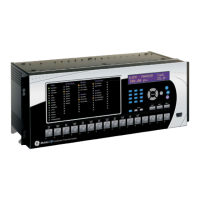5-66 T35 TRANSFORMER PROTECTION SYSTEM – INSTRUCTION MANUAL
PRODUCT SETUP CHAPTER 5: SETTINGS
5
• A v7.4 device cannot send an R-GOOSE message to non-R-GOOSE devices, such as v7.3 or v5.9 UR device
• UR devices with firmware below v7.3 can send a GOOSE message to a v7.4 device that has GOOSE as the active
protocol
TxGOOSE
IEC 61850 GOOSE is an efficient method for simultaneous high-speed delivery of generic substation event information by a
publishing device to more than one subscribing device. A TxGOOSE is a UR element implementing a single IEC 61850
GOOSE message publishing service. The subscribing function in URs is performed by RxGOOSE elements, as described in
the next section. Each UR with IEC 61850 order code options has 16 TxGOOSE elements. Each TxGOOSE can either use the
original format specified in IEC 61850 8 1:2011 or the routable GOOSE (R-GOOSE) format specified in IEC TR 61850-90-
5:2012. Each TxGOOSE element can publish the values of up to 64 attributes of the IEC 61850 nodes in the UR.
Published TxGOOSE messages configured in the EnerVista UR Setup software can be subscribed by and the published
operand values understood by other UR devices. Furthermore, they can be subscribed to and understood by any device of
any manufacturer that implements the IEC 61850 edition 1.0 or 2.0 GOOSE subscription mechanism. The messages are
published with a multicast address so that the network sends the messages to all devices; any number of devices that
want to subscribe can.
For wide area protection, control, and monitoring schemes, R-GOOSE wraps the proven original format GOOSE in IP/UDP to
multicast (or unicast) the data over a Wide Area Network (WAN). Sample applications are Wide area Remedial Action
Scheme (RAS) and Under Voltage/ Frequency Load Shedding Schemes (UVLS/UFLS). R GOOSE uses IGMPv3 (Internet Group
Management Protocol version-3, RFC 3376) for multicasting.
The entities whose values are published in GOOSE messages are known as members. The members are itemized in an
ordered list known as a data set. Each TxGOOSE can use any one of the configured data sets. (See the DataSets section
later for details.) The performance of a TxGOOSE is determined by its dataset. Booleans in fast GOOSE datasets are
designed for the TT6 transfer time class (3 ms), while Booleans in the Normal datasets are designed for the TT3 class (100
ms). Due to the significant amount of CPU time required to compose a TT6 TxGOOSE message and the limited amount of
time allowed by the TT6 class, at most four of these can be configured in a given UR. So only four fast GOOSE are allowed
to be configured, and the UR software has a check to disallow the use of more than four fast datasets in GOOSE. If six fast
datasets are configured outside of UR software and the file sent directly to the relay, the relay rejects the file. The design
does allow six fast datasets to be used in report control blocks, which allows fast scanned data in reports.
Each enabled TxGOOSE transmits its message whenever a value change is detected in one or more of its members. If the
changed value is a Boolean in a fast dataset, then the change detect occurs in the TT6 detection time of 3 ms or less. If the
member is an analog value in a fast dataset, the change detect occurs in theTT3 time of 100 ms. In Normal GOOSE
Datasets, change detection for all dataset members occurs in the TT3 time of 100 ms. To guard against the possibility that
such a message is lost in the network before it reaches all subscribers, the message is quickly retransmitted several times.
To allow subscribers to verify that their link to the publisher and the publisher itself are healthy, each message is also
retransmitted periodically even while the values are unchanging. These latter messages are known as heartbeat
messages, while the former are known as event messages. Heartbeat messages also provide means for a subscriber
newly online to receive the published values in the absence of an event.
The details of TxGOOSE message construction are contained in the UR Family Communications Guide. Knowledge of these
details is not required to configure GOOSE.
The UR does not implement the Fixed-Length encoded GOOSE messages option specified in IEC 61850-8-1:2011 clause
A.3; the UR always uses the ASN.1 Basic encoding rules (as specified in ISO/IEC 8825-1) as specified in IEC 61850 edition 1.0
and as optional in IEC 61850 edition 2.0.
Navigate to Settings > Product Setup > Communications > IEC 61850 > GOOSE > TxGOOSE > TxGOOSE1 to access the
settings for the first TxGOOSE. The settings and functionality for the others are similar.
R-GOOSE is available through the IEC 61850 software option. If R-GOOSE security is required, the CyberSentry
software option also must be purchased.

